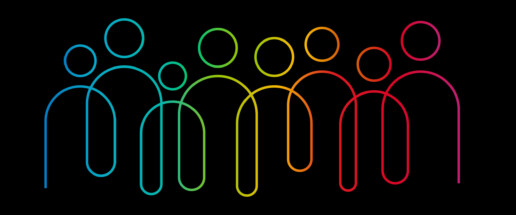Guest Post: Celebrating Asian-Americans: Reflections on Solidarity and Success in the Sunlight
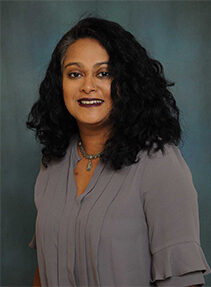
Cyra Akila Choudhury
Professor of Law
FIU College of Law
Center for Law and Digital Technologies, Leiden University
Asian Americans have been in the news a great deal in the last several years. This year has been the year for Asians in the movies. Over the pandemic years, Asians and Asian Americans were in the news regularly for being victims of racial harassment and violence. That violence reached its extreme in the Atlanta massacre of six Korean American women working at a spa. The brief outpouring of support and solidarity after the shootings were welcome but not sustained. Within months, Asians went back to being a marginal minority group.
Even though we are the fastest growing minority, too often, we are only given attention in extraordinary moments: when we are the agents (Oscar winners, school shooters) or objects (victims of violence) of spectacular events. The most recent sustained attention given to Asian Americans has been in the context of the legal attacks on affirmative action.[1]
As Asians, we occupy the spotlight but not the sunlight, solidarity ebbs and flows, and our excellence is a double-edged sword. In this blog post, I reflect on the ways in which we have become agents for change in ways that overcome the binary glare of the spotlight or dark of its shadow. Asians have practiced and should continue to commit to radical solidarity both among ourselves and with other groups even as we unapologetically embrace our excellence. I offer these reflections as part of an ongoing conversation about what it means to be Asian American—an umbrella that includes a diverse group of people—in this moment.
- Seeking the sunlight not the spotlight
We are used to not being seen and not attracting attention to ourselves. Psychologist Jenny T. Wang writes in Permission to Come Home: Reclaiming Mental Health as Asian Americans,[2] that safety was one of the primary needs of her immigrant family. Safety meant following the plan of achieving stability and success without fuss. Often this means that we keep our heads down and get the job done, sacrificing what we truly love for the sake of duty. The light is shone on us by others when they perceive something worthy of notice.
In short, unless we are winning Oscars, running Google, or being massacred, people really don’t notice Asians. This is the spotlight effect. An external gaze that lights us up temporarily. As law students and lawyers, this might happen when we win an award or a big case. But what about when we’re not winning something? Asians deserve the sunlight and not the spotlight. That is to say, rather than being content with attention primarily when we achieve excellence, we deserve to be visible and present just as we are. Living in the sunlight also means being willing to be seen in our various workplaces and in society. Raising our hand in class, speaking in our own voice, running for public office, applying for promotion, and owning our histories and accomplishments.
- Practicing radical solidarity
Asia is a vast geography with ancient civilizations. “Asian” is not a race, a cultural group, nor a linguistic group. Asian Americans hailing from different parts of Asia are a diverse group with many sub-diasporas. In legal education, for instance, Asian Americans include those with ancestors from China, Korea, India, the Philippines, Japan, and Vietnam. Increasingly, the shared experiences of these communities in the U.S. based on political marginalization, racism, immigration, and some cultural values have led to a growing sense of shared identity as well.
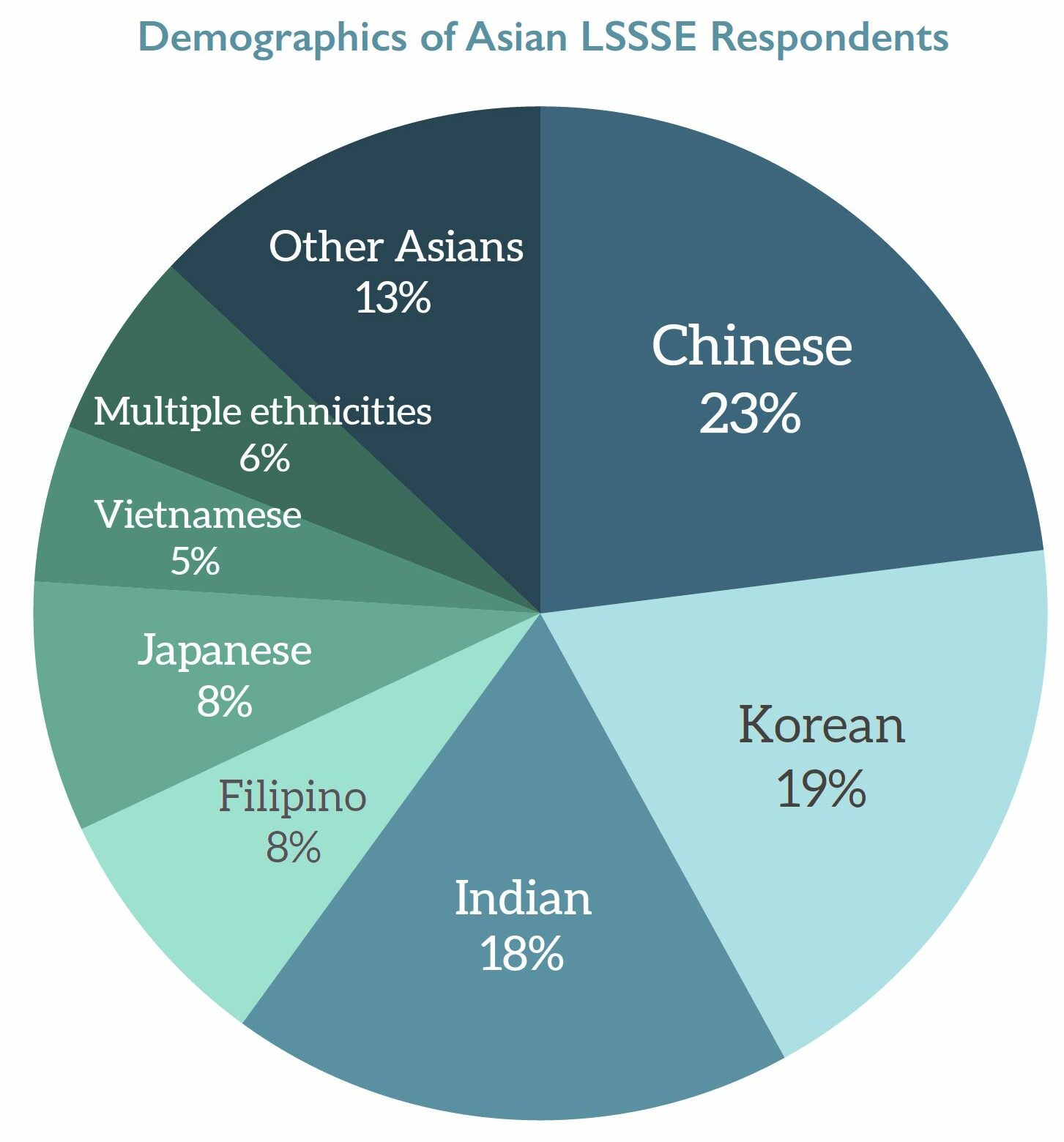 Yet, much more work needs to do be done to forge these nascent bonds. After the Atlanta massacre and the pandemic related violence against East Asian communities, there was a surge of broader recognition that Asian Americans were subjects of racism. This massacre was preceded by the massacre of six Sikhs in Wisconsin in 2012. This too was an Asian massacre and yet, we rarely connect the two as anti-Asian racism. Solidarity among Asians in an increasingly polarized political society has become very important if we want to shape and direct change.
Yet, much more work needs to do be done to forge these nascent bonds. After the Atlanta massacre and the pandemic related violence against East Asian communities, there was a surge of broader recognition that Asian Americans were subjects of racism. This massacre was preceded by the massacre of six Sikhs in Wisconsin in 2012. This too was an Asian massacre and yet, we rarely connect the two as anti-Asian racism. Solidarity among Asians in an increasingly polarized political society has become very important if we want to shape and direct change.
Asians have been partners in all of America’s struggles: the civil rights movement, labor rights, anti-war protests, and resistance to the War on Terror. We have demonstrated our solidarity with other groups, and we must do the same within our Asian communities as well. Radical solidarity, as I define it, means showing up for the struggle when called. When Black communities call for resistance, we show up. When Latinx communities ask for solidarity, we show up. Same for feminists and LGBTQ communities. We cannot succeed meaningfully in isolation. These struggles overlap within our communities. Moreover, radical solidarity is something we do without taking stock. I recall an acquaintance remarking in response to the Atlanta massacre, “I’d like to support Asians Americans, but they call the cops,” This is the opposite of radical solidarity. It is contingent solidarity and as we all know, fair-weather friends are of limited value. No single group has succeeded without radical solidarity from other groups. Without the civil rights movement, many of us would not even be Americans.
For law students, radical solidarity means working with other groups, showing up for their events, collaborating with others. LSSSE data make clear that law students excel at this already, both having serious conversations with students of a different race and working to understand students from different racial backgrounds.
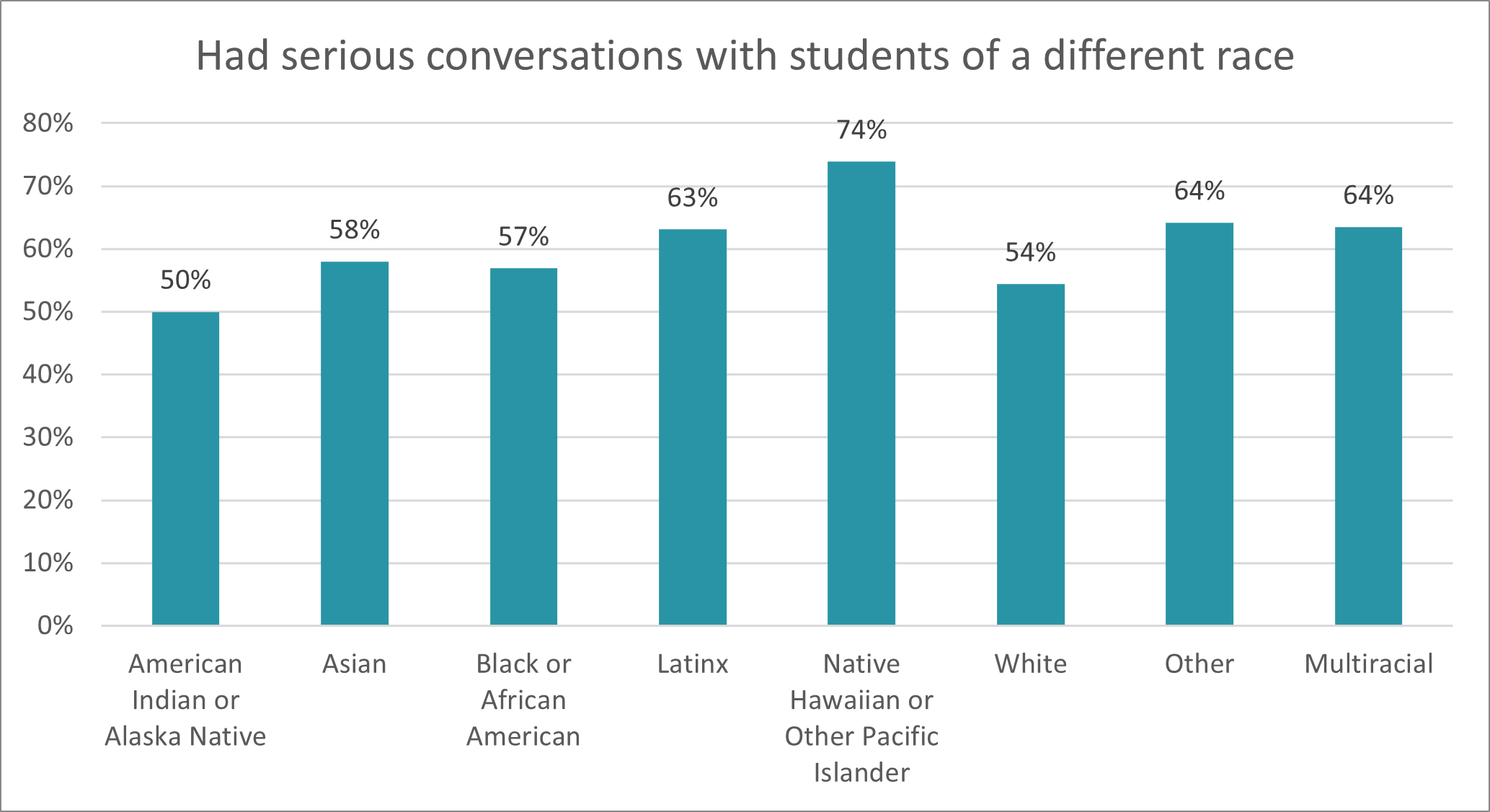
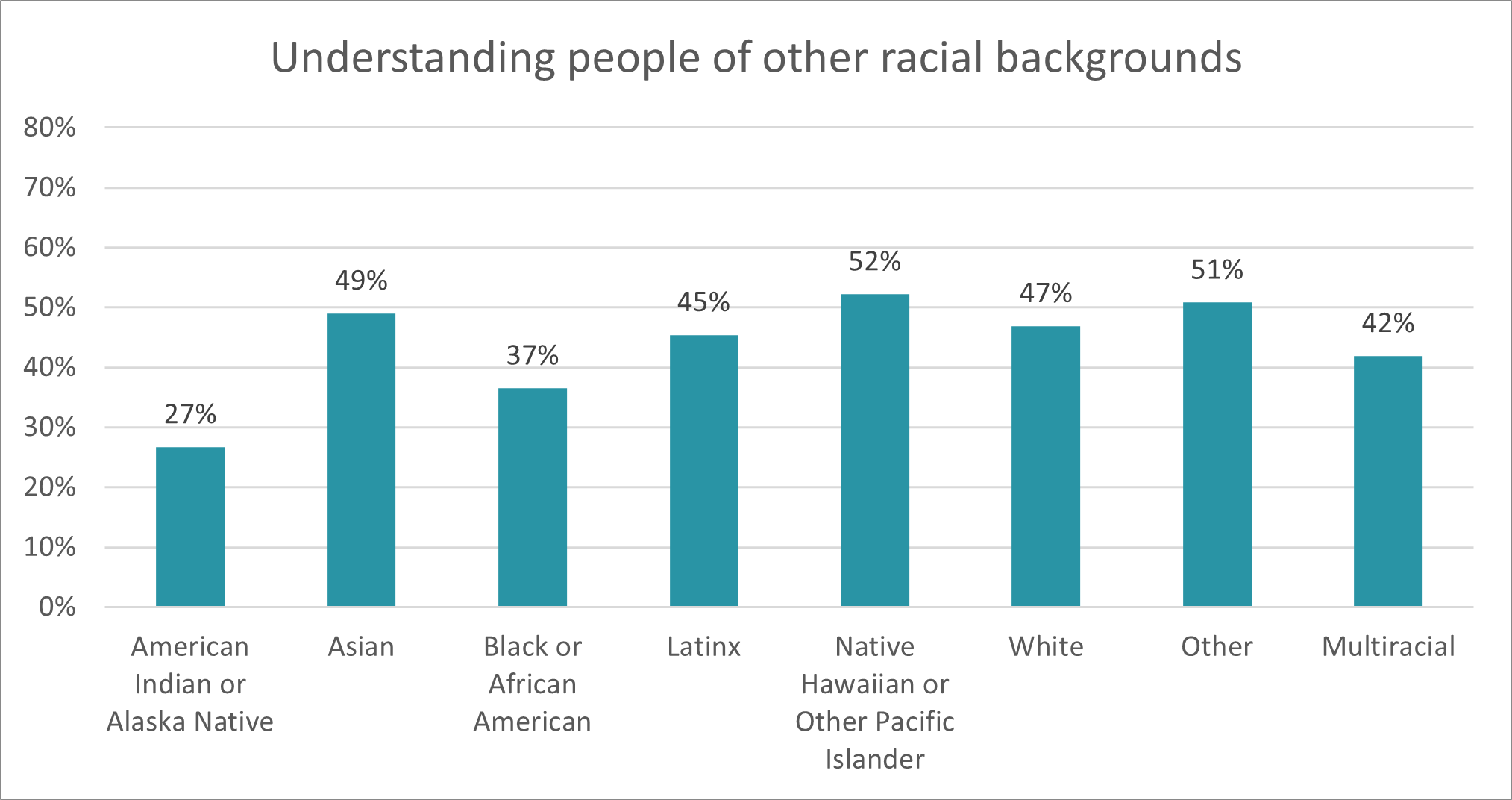
For law professors, it means mentoring across various communities, perhaps reading across histories and cultures, and comparative research. For lawyers, it means building professional bridges and perhaps doing pro bono work for the communities that need it. Radical solidarity might require humility but not apology. I’m sure that there are many in our communities with very different ideas and politics but I speak here to the majority of us who believe in social equality.
- Embracing excellence and failure
Asians Americans are known as the “model minority.” It’s a pernicious myth about exceptionalism that is used to chastise other minority groups. In the last few years, weaponizing Asian excellence to harm other minority groups has been difficult for most Asians because we support affirmative action. How do we celebrate the very excellence that has been used to falsely exceptionalize us? Others have written extensively about the harms of this myth not only to others but to Asians themselves. Here I want to reflect on another consequence: a reluctance to embrace our successes and excellence as a community because it reinforces the myth.
The model minority myth has led to an ambivalence in celebrating our communities’ successes—an obstacle that few other groups have had to overcome. Achieving success because of hard work should be celebrated for itself while understanding that it says nothing about the value and success of any other group. Our radical solidarity with marginalized groups prevents us from claiming any exceptionalism for ourselves. And celebrating Asian Americans who succeed should not be mistaken for it. Nor should it be denigrated as mere borrowing, assimilationism, or white adjacency which is another kind of negative exceptionalism. Other groups’ similar successes are rarely spoken of in these denigrating ways.
So, celebrate the Indian kids who win spelling bees, the Chinese kid who wins the math competition while rejecting that Asians are somehow exceptional at spelling or math! Our stars are just that: stars. We have exceptional talents who deserve to be celebrated.
I want to end on a positive note on what is commonly thought to be a negative experience: failure. One stereotype about Asians is that, in our families and communities, failure is not an option. However, we should embrace failure as part of success rather than as a shameful shortcoming. As a law professor, I tell my students that they should learn from their failures, admit to them, overcome them, and move forward. Failures are inevitable and learning to cope with them without shame is important to the mental health of the community.[3] Asians fail as much as any other group and to deny this is to enforce an unacceptably high standard. To fully lay the model minority myth at rest, we must accept both our success and our failure. Asian belonging is not contingent on group accomplishment or excellence. We deserve the sunlight, to be visible, and fully accepted as Americans when we’re winning as well as when we’re not.
____
[1] Students for Fair Admissions v. Harvard; Students for Fair Admissions v. University of North Carolina
[2] Jenny T. Wang, Ph.D., Permission to Come Home: Reclaiming Mental Health as Asian Americans (2023).
[3] See id.
Learning Effectively on Your Own
Working independently and working collaboratively are both important skills for budding legal professionals. In addition to learning through classroom experiences, law students must assume responsibility for learning large amounts of material in a relatively short period of time, often independently and sometimes in small groups. We examined the extent to which law students feel that their experiences in law school have contributed to their personal development in both learning effectively on their own and working effectively with others.
Four in five law students say that law school helped them “quite a bit” or “very much” in developing the ability to learn effectively on their own. Fifteen percent say that they developed “some” skills in this area, and only four percent said they developed “very little.” By comparison, only about half (52%) of law students learned “quite a bit” or “very much” about working effectively with others. A little more than a third (36%) developed “some” skills in this area, and more than one in ten (12%) learned very little about working effectively with others.
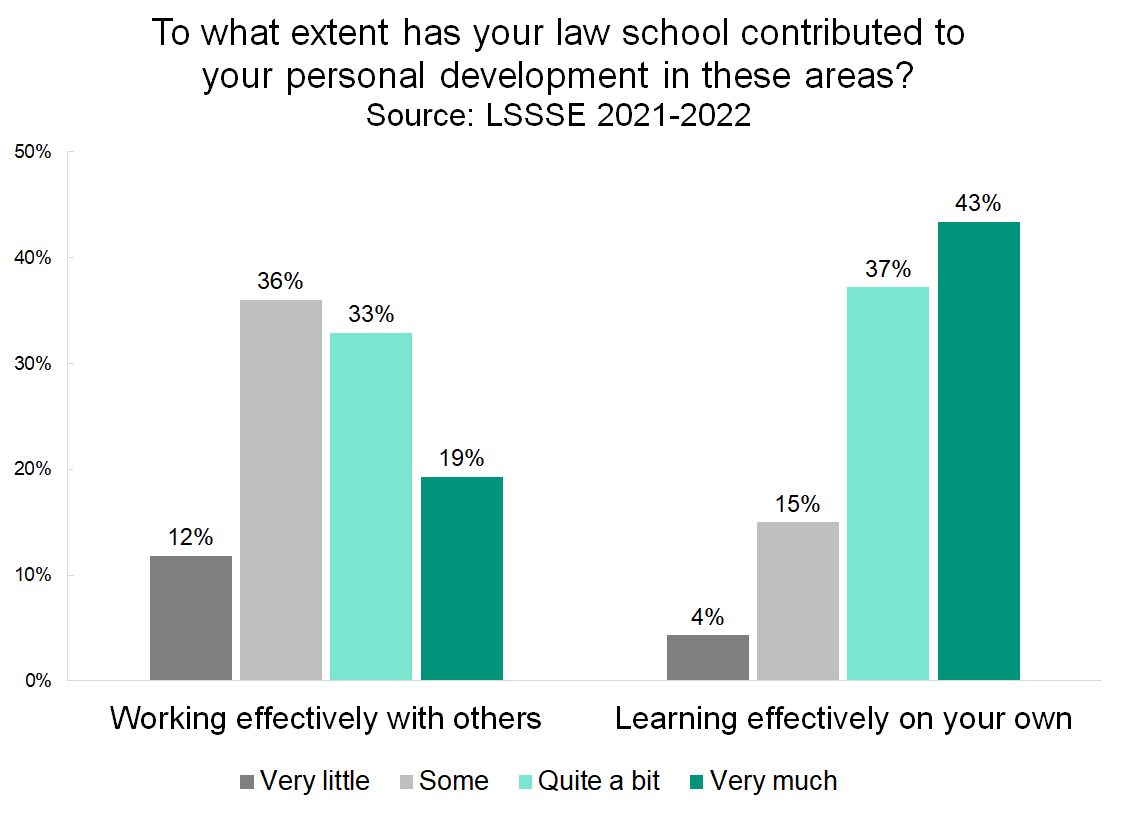
Students who greatly enhanced their ability to work on their own generally feel both that their law school has high standards and that their law school adequately supports their academic endeavors. Nearly all (92%) of students who significantly enhanced their independent learning skills felt that their law school emphasizes spending significant amounts of time studying and on academic work compared to 84% of their colleagues who developed fewer skills in this area. Additionally, over two-thirds (69%) of students who honed their ability to learn independently felt that their law school provides the support they need to succeed academically compared to only 38% of their peers. Rigor and institutional support work together to drive student achievement.
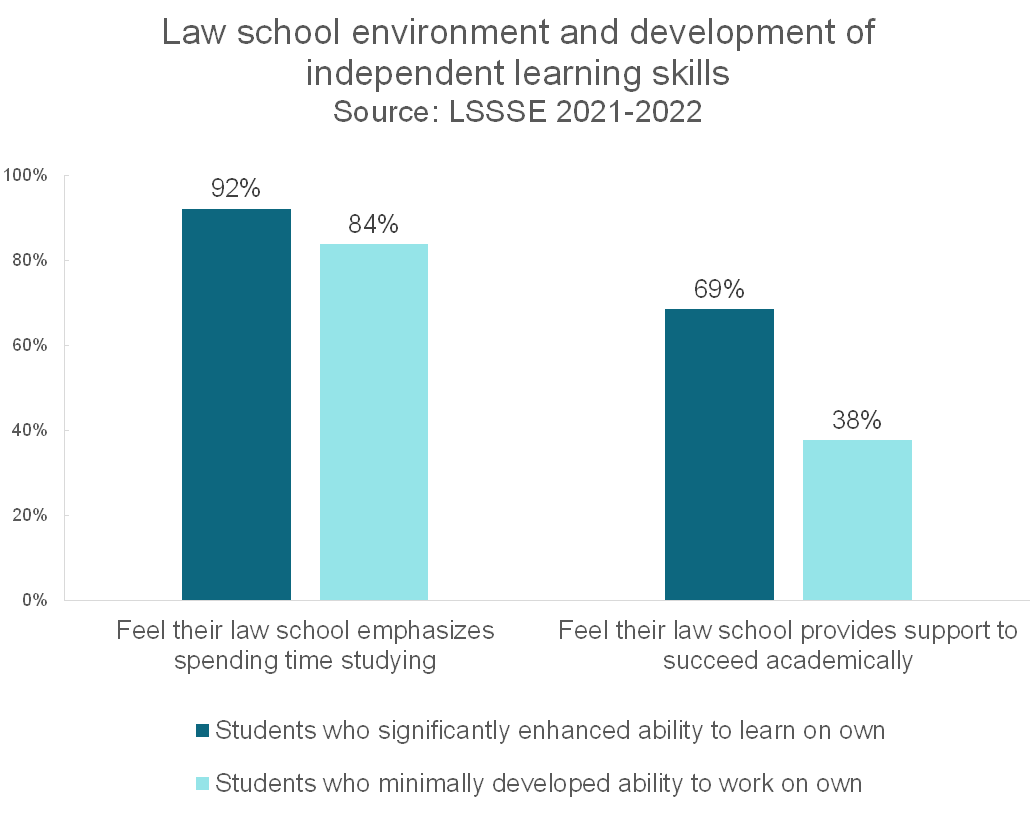
Students who substantially enhanced their ability to learn independently were more likely to revise course assignments at least once and to engage more deeply with course content. Sixty-three percent of independent learners frequently prepared two or more drafts of a paper or assignment and 84% were frequently required to integrate ideas from multiple sources in papers or course assignments. Students who developed independent learning skills were more likely to frequently discuss assignments with faculty compared to students who developed less of an ability to learn independently. Perhaps crucially, the independent learners were more likely to frequently receive prompt feedback from faculty (50% received prompt feedback "often" or "very often") compared to law students with less-developed independent learning skills (29% received prompt feedback "often" or "very often"). Deep, sustained learning is often an iterative process that requires feedback from experts, and this is borne out by the LSSSE data.
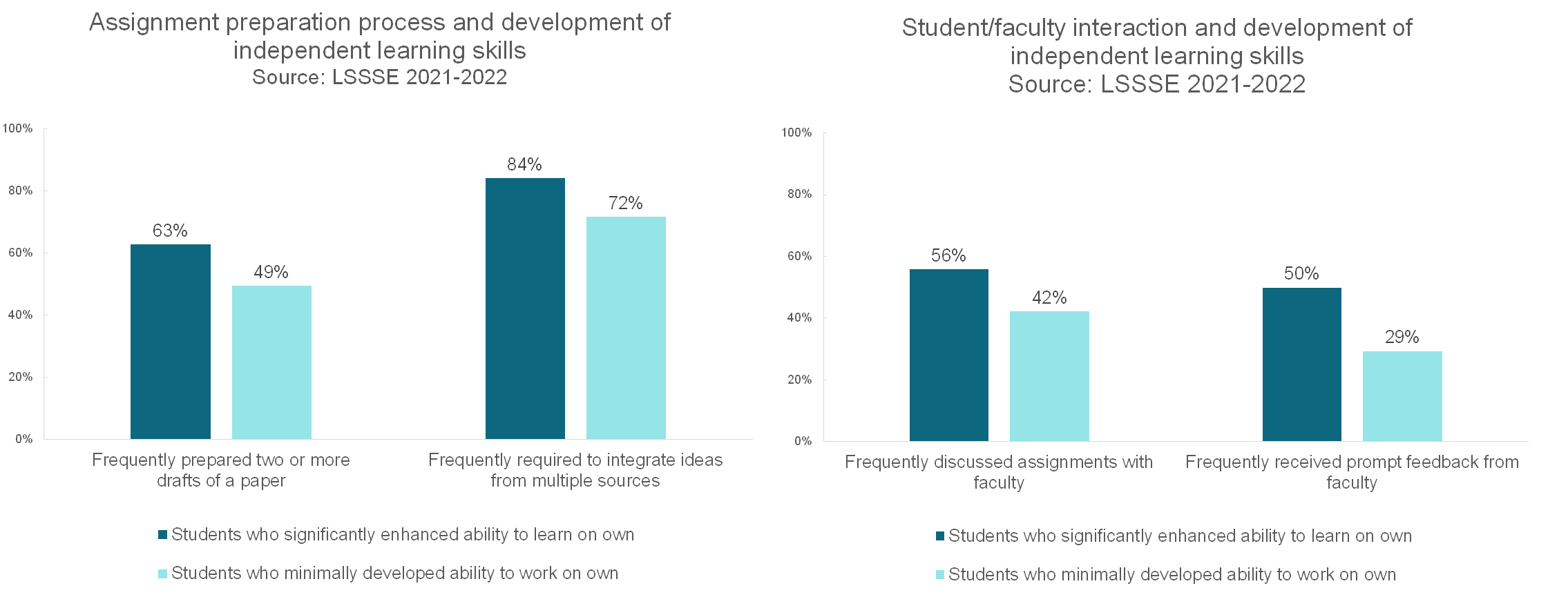
Next month we will look at how students who feel law school has contributed substantially to their ability to work effectively with others differ from those students who do not feel this way. We will also consider how interpersonal effectiveness skills might affect attitudes toward diversity.
Law School Support for Non-Academic Responsibilities
Law students vary in their amount and type of non-academic responsibilities, and they also vary in the degree to which they feel that their law school helps them cope with these responsibilities. In addition to their studies, some law students work, care for children or other dependents, and engage in community activities. We wanted to examine the degree to which students feel supported in these endeavors by their law schools.
Time Spent Caring for Dependents
Thirty-eight percent of law students spend at least one hour per week caring for dependents living with them (parents, children, spouse, etc.). Interestingly, there is little difference in the percentage of students with and without dependent care duties who feel that their law school emphasizes helping them cope with their non-academic responsibilities. About a quarter of each group (26% of students with dependents and 24% of students without dependents) feel well-supported. However, students with dependents are slightly more likely to say that their law school does very little to help them cope with non-academic responsibilities. Two out of five (42%) of students with dependents feel this way compared to 38% of students without dependents.
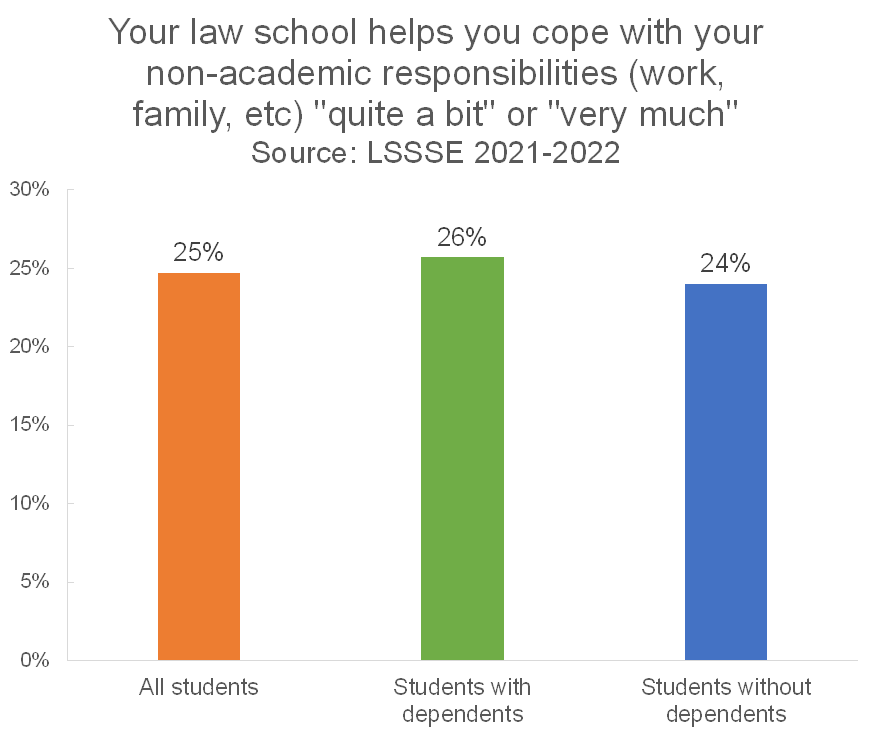
Gender and Dependent Care
However, there are huge differences by gender. Men with dependent care responsibilities are much more likely to feel supported by their law schools than women with dependent care responsibilities, and both groups feel more supported than people of other gender identities with dependent care responsibilities.
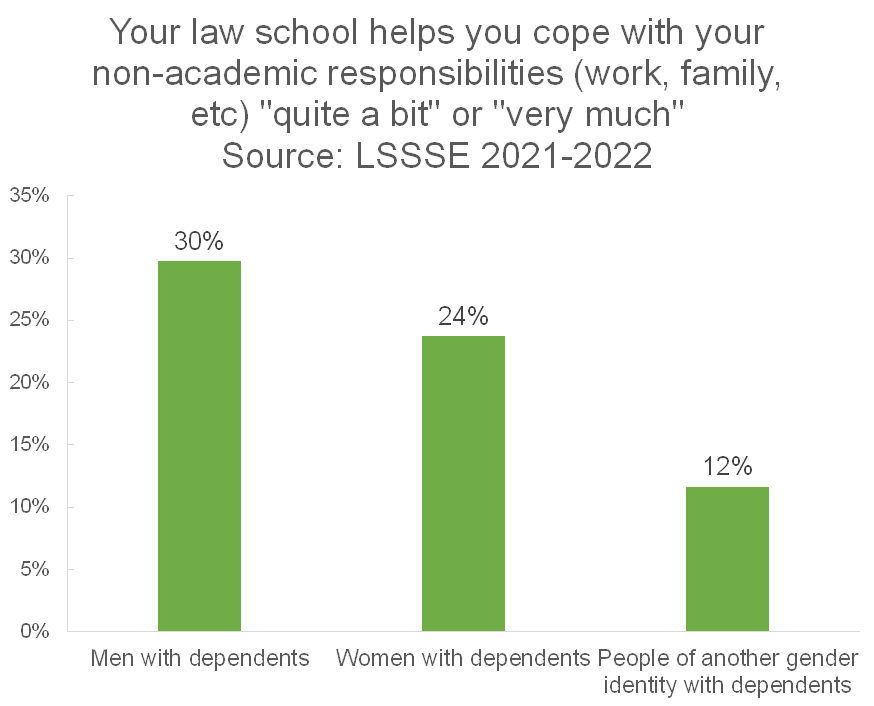
It appears, however, that this effect is more about gender and less about the dependent care responsibilities as we see this same disparity across gender among people without dependent care responsibilities.
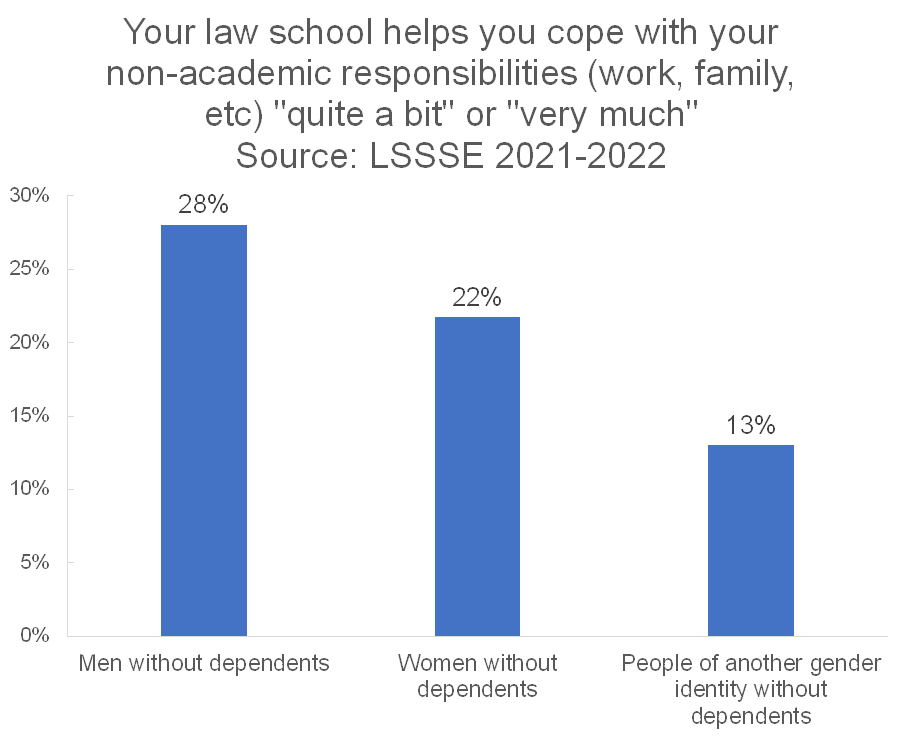
Time Spent Working for Pay
Similar to the pattern we see with dependent care duties, there is minimal difference in the perceived level of support for non-academic responsibilities between students who have jobs and students who do not. Around one in four students in either category say that their law school emphasizes supporting their non-academic responsibilities.
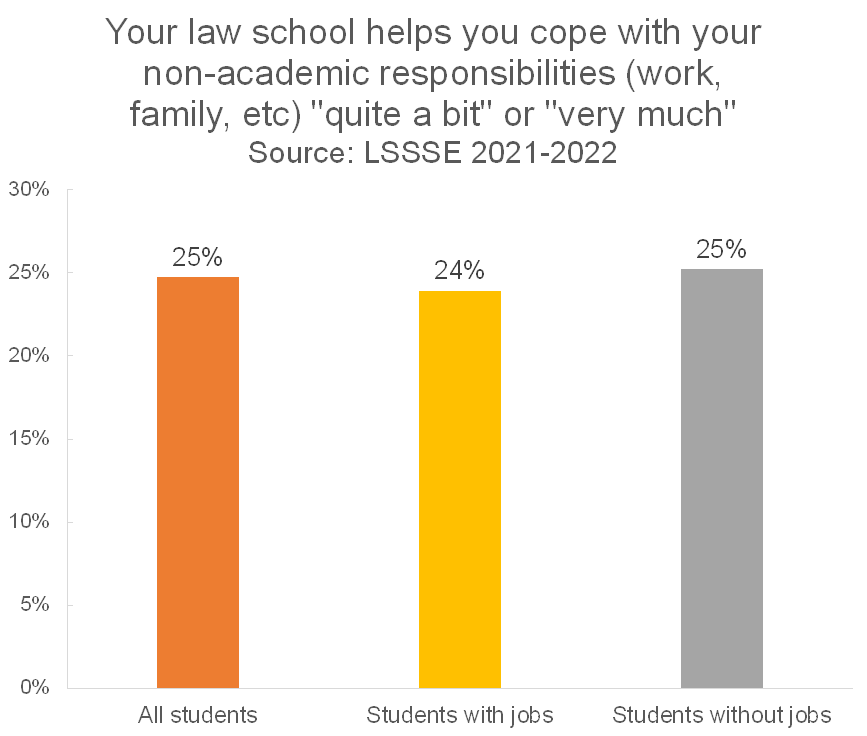
Gender and Employment
The gender pattern for perceived support is much the same for working/non-working students as it is for dependent care duties. Men are more likely to feel high levels of support than other students. However, people who identify as neither men nor women are actually more likely to feel highly supported in their non-academic responsibilities when they are employed (20% of students) relative to when they are not (6% of students).
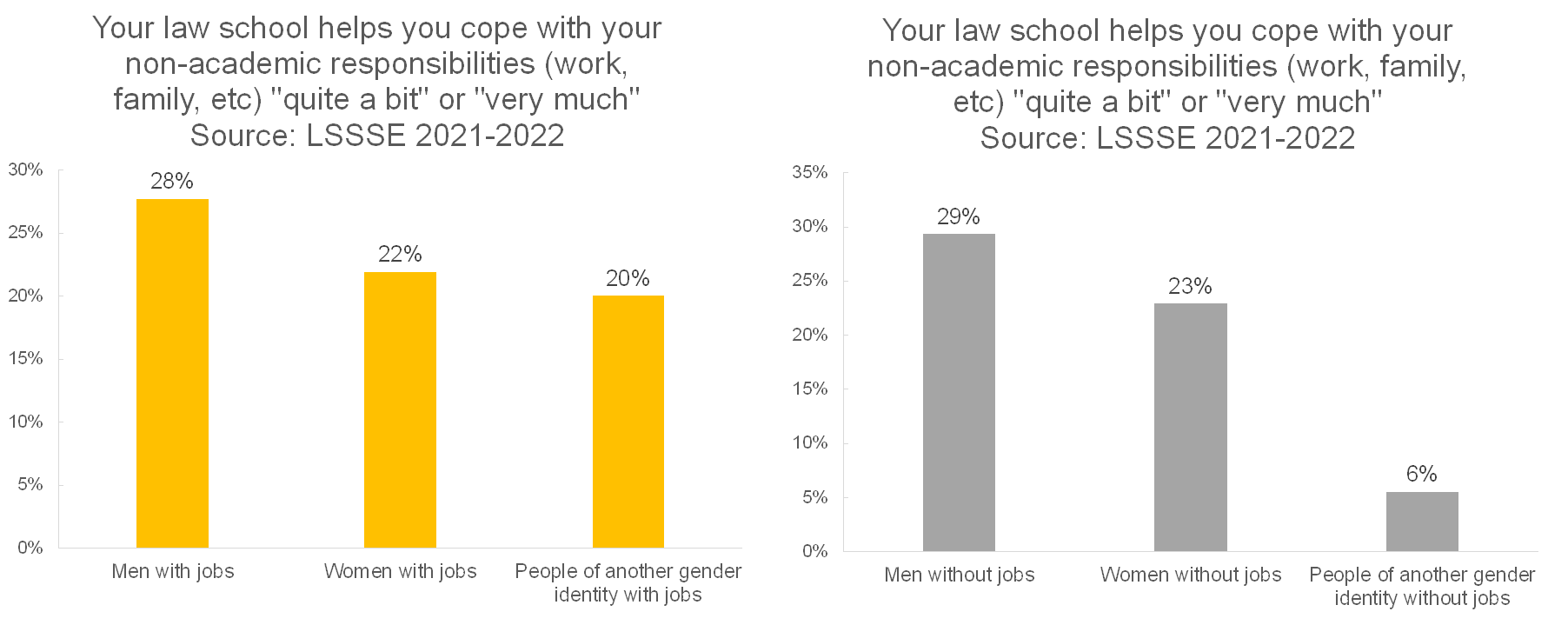
Regardless of how they spend their time outside of law school, men are much more likely to feel highly supported in their non-academic responsibilities, people of another gender identity are very unlikely to feel supported, and women generally fall somewhere in between. Adequate support for non-academic responsibilities clearly looks different for different people, and it appears that gender is a major factor. Rather than focusing on student populations based on which responsibilities they have and how they spend their time outside of the classroom, law schools may want to consider the unique needs of women and people of other gender identities to close the gap in the degree of support they feel about coping with their non-academic responsibilities.
Guest Post: Suits for Success

Colin Miller
Professor of Law
University of South Carolina School of Law
In 2018, I saw a tweet thread by attorney Alyssa Leader offering advice to law students on purchasing professional clothes on a budget. The thread was inspired by Leader’s memories of being a 1L and trying to swing a new wardrobe on student loans for job interviews. It led to me recalling my own time as a 1L, when all I had were ill-fitting Dockers and dress shirts, samples from my dad’s job as a Levi’s salesman. Knowing that many of my students faced similar issues, I researched whether any programs existed where job applicants could borrow professional clothes.
I came across the “tiebrary” program at the Paschalville Branch of the Free Library of Philadelphia. In a neighborhood with high rates of poverty, unemployment, and citizens returning from incarceration, the program allows patrons to check out professional clothes for job interviews. Further research revealed that this program was inspired by a similar one at the Queens Public Library, started when a library assistant gathered unused, clear VHS cases to display ties that patrons could check out. Articles on both of these programs sung their praises, with patrons crediting some of their success in the job market to their ability to dress for success.
Having fallen down the rabbit hole, I read studies suggesting that wearing professional clothes not only increases confidence and the chances of being hired, but also thinking and negotiating skills. Given how critical such skills are to success in summer jobs, I thought that a similar program for the students at our law school shouldn’t involve rentals; it should allow them to keep those clothes and wear them while they worked, not merely while they tried to be hired.
And thus, Suits for Success was born. First, we needed a space to house the program. Luckily, my Associate Dean counterpart, Susan Kuo, had started a free pantry for food insecure students. The space was big enough to house not only non-perishable food, but also a few clothing racks, allowing for one-stop shopping. After I took a trip to IKEA, we had all of the infrastructure we needed for the program.

Now, we simply needed to stock the space with suits, skirts, slacks, and other accessories for our clothing insecure students. Therefore, with assistance by my research assistant A.C. Parham, we conducted a month-long clothing drove where students could donate new and gently used professional clothes. We placed receptacles around the school where our students could drop off clothes that could help their classmates land the jobs of their dreams. Many of our students were thrilled at the opportunity to help their fellow students, building a sense of camaraderie around the law school.

But it went further than that. We promoted Suits for Success on social media, and it led to local lawyers seeing and understanding the need for the program. Soon, we started getting donations from members of the bar, who now better understood the financial issues facing our students and how they are orders of magnitude larger than the ones they faced when they were in school.
These are some of the same issues identified in the LSSSE data, concerns about making ends meet that disproportionately impact women and students of color. For instance, LSSSE data show that first-gen students (those who are the first in their families to attend college and therefore less likely to have professional clothes as hand-me-downs) also have the highest debt levels—leaving little extra money to spend on a new wardrobe. Financial concerns are also a huge source of stress for first-gen students, and many others. Being able to alleviate this in even a small way through Suits for Success is a simple way to support our students.
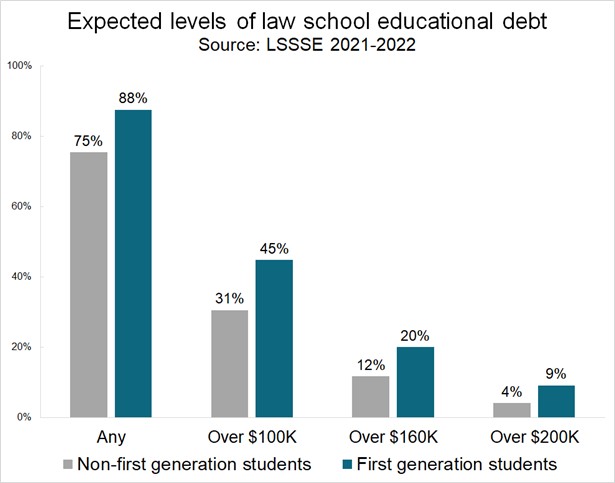
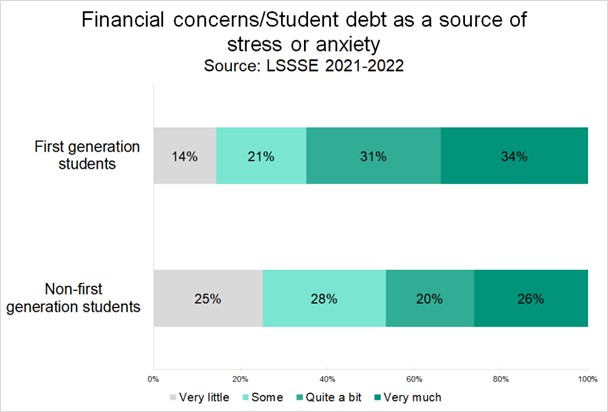
There are, of course, systemic issues that our food pantry and Suits for Success cannot and do not address. But we hope that these programs can at least make the difference at the margins and offer our students some security that they otherwise wouldn’t have.
Better than BIPOC
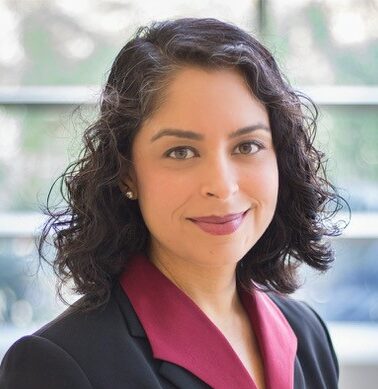 Meera E Deo, JD, PhD
Meera E Deo, JD, PhD
The Honorable Vaino Spencer Professor of Law, Southwestern Law School
Director, Law School Survey of Student Engagement (LSSSE)
We should be precise with our language, especially when talking about race. In “Better than BIPOC,” I argue that BIPOC is a flawed term for empirical scholars to use, one that prioritizes historical oppression over ongoing realities and relies on virtue signaling rather than working toward meaningful change. In my previous essay “Why BIPOC Fails,” I explain how BIPOC can be misleading, confusing, and contribute to the invisibility of the very groups that should be centered in particular contexts. Thus, without the deep investment of community engagement and review, new labels—like BIPOC—run the risk of causing more harm than good. Instead, we should continue to use the term “people of color” when referencing this group in comparison to whites, while “women of color” is useful when considering raceXgender intersectionality. Banding together for mutual support and action has been critical for people from marginalized identities as they have worked toward lasting social change. Additionally, it is often important to disaggregate data to report on individual groups that could otherwise get lost under these larger umbrella terms.
The experiences of various communities in law school help illustrate the point that academics, advocates, and allies should use be careful in their language usage—especially when dealing with data. Grouping populations together is often instructive. It can also be necessary to disaggregate the data to deal with separate communities individually. Law student debt and experiences with issues of diversity are particularly instructive in explaining both paths.
First, LSSSE data reveal that students of color carry more educational debt than white students. Here, it is appropriate and useful to group students of color together as a whole in comparing them with white students in terms of their overall debt loads. However, we can dig deeper to consider the intersectional experience of gender combined with race. If we ignore gender in this context, we run the risk of masking the distinct experiences of women of color compared with men of color as well as other groups. And there are differences. As I write in the article, “[H]igher percentages of Women of Color (23%) graduate with over $160,000 in law school debt, as compared with Men of Color (18%), white women (15%), and white men (12%).” While examining debt by raceXgender is thus more useful than considering race alone, being even more precise with the data and our language provides an opportunity to reveal more nuanced realities for communities within the women of color umbrella. As we share in our 2019 LSSSE Annual Report, The Cost of Women’s Success, the raceXgender groups most likely to carry the highest debt loads of over $200,000 are Latinas (16%) and Black women (14%), compared to lower percentages of Asian American women (7.7%), Black men (7.3%), Latino men (12%), and white men (4.3%). Thus, while it is correct to talk about the people of color and women of color carrying more debt than whites and those who are not women of color, it is more complete and sophisticated to explain how particular raceXgender groups—Black women and Latinas—have the highest debt loads of all. Precise racial language is instructive, particularly if we seek to craft solutions to ameliorate these challenges that are directly responsive to the needs of the populations affected.
Student experiences with diversity provide another example of the benefits of careful language usage. Compared to their white peers, students of color have distinct opinions and experiences in law school when considering issues of diversity, equity, and inclusion. For example, although almost one-third (31%) of white law students “strongly agree” that they see themselves as part of the law school community, students of color are less likely to agree. As with debt levels, there are again additional distinctions based on raceXgender. In Better than BIPOC, I draw on data from the LSSSE 2020 Annual Report, Diversity & Exclusion, noting, “Fewer than one-quarter (23%) of women of color ‘strongly agree’ that they are part of the institutional community, compared to almost one-third (31%) of men of color.” Thus, distinctions based on race alone are not as precise as those disaggregating racial data by gender. In certain contexts, we also can—and should—go further still. By looking within the category of people of color, we can determine important differences between groups that administrators, faculty, and staff should consider in order to tailor solutions to the students who most need them. For instance, when we consider student belonging, “only 21% of Native American and Black law students see themselves as part of their law school community—compared to 31% of their white classmates, 25% of multiracial students, 26% of Asian Americans, and 28% of Latinx students.” Considering the student of color narrative as one group would tell an incomplete story as Black and Native law students are even more alienated nationally than even other students of color. Addressing their concerns will require us first to understand them, then to act.
Better than BIPOC also draws from the data behind my book project, Unequal Profession: Race and Gender in Legal Academia, to share examples from the law faculty context. I use findings on student evaluations and the challenges different populations face while navigating work/life balance to suggest when we should compare faculty of color as a whole to their white colleagues, when to disaggregate by race as well as gender to examine the experience of women of color faculty, and when to look more carefully within racial and gender-based categories to reveal important distinctions that could otherwise be hidden. Beyond the context of legal education, we can apply this thesis to frameworks as diverse as political engagement, workplace harassment, elementary school integration, diversity in corporate boards, and more. Different situations will naturally call for specific groups to be named and studied directly; that context, regardless of the terms currently en vogue, should drive the data used and arguments made in any endeavor. Working collectively serves a purpose, as does disaggregating the data. Through both efforts, we can understand the unique challenges facing different groups and work collectively to address them.
Part 2: Part-Time Students & the Law School Experience
Part-time law students tend to be particularly happy law students. Four out of five part-time students (81%) rate their overall law school experience as good or excellent compared to 77% of full-time students. In fact, 37% of part-time students give their school an excellent rating compared to just 29% of full-time students. Most part-time students (83%) would choose to attend law school again if they could start over, and a similarly high proportion (86%) would choose the same school they are currently attending.



Part-time students feel a level of support from their law schools that is generally on par with – or higher than – the level of support experienced by their full-time colleagues. Two-thirds of part-time students feel that their school is providing the support they need to succeed academically. Around half feel that their law school is providing the support they will need to succeed to succeed in finding employment. Only a quarter of part-time students feel that their school provides the support they need to thrive socially, although this is nearly identical to the 26% of full-time students who feel similarly. Part-time students may require somewhat different considerations than their full-time peers, but they generally feel that their law schools provide adequate assistance to allow them to be successful.
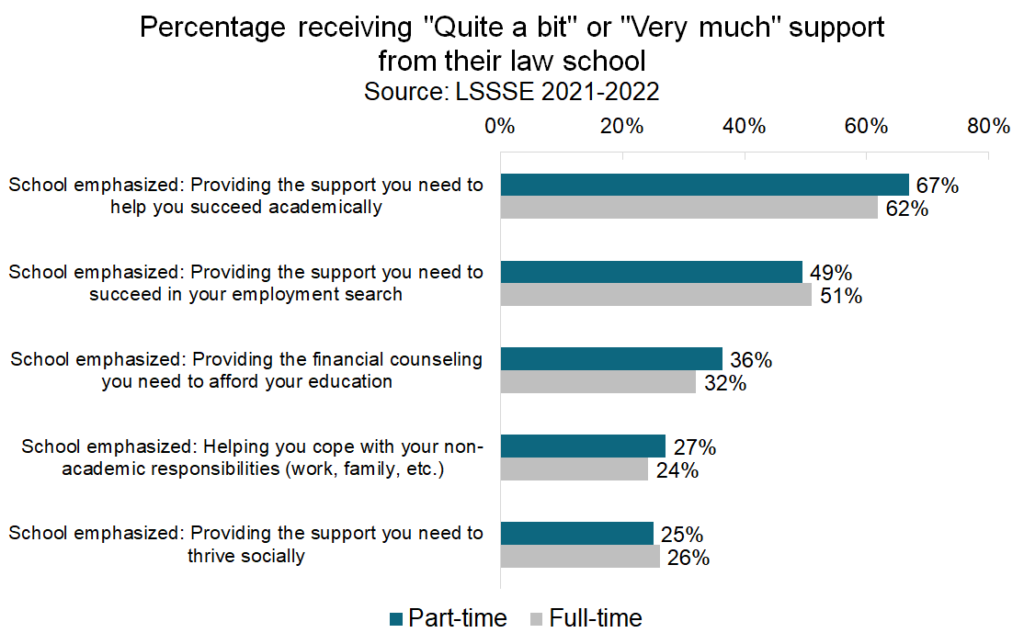
Part-time students feel a strong connection to their law schools. They are fairly satisfied with the resources their law schools provide, and they are quite satisfied with their overall experiences as law students. Although their experiences as law students may be slightly untraditional, they are still highly engaged and active participants in their programs of legal study.
Guest Post: Introducing the Antiracist Development Institute
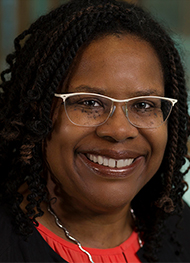
Danielle Conway
Dean and Donald J. Farage Professor of Law
Penn State Dickinson Law
In 2020, the cascade of murders of Black and Brown individuals and the Black Lives Matter protests demonstrated the prevalence of systemic, structural, and institutional racism. Structural racism permeates our democratic institutions, including legal education and the legal profession. For example, LSSSE data from that same year reveal that “[a]lmost a quarter (23%) of Black law students nationwide say their schools do ‘very little’ to create a supportive environment for race/ ethnicity, compared to just 6.8% of White students.”

Similarly, the LSSSE 2020 Annual Report Diversity & Exclusion revealed that students of color need greater institutional support to avoid being stigmatized on campus, as “14% of Native Americans, 18% of Latinx students, and a full quarter (25%) of Black students believe their schools do ‘very little’ to emphasize that students are not stigmatized based on identity.”
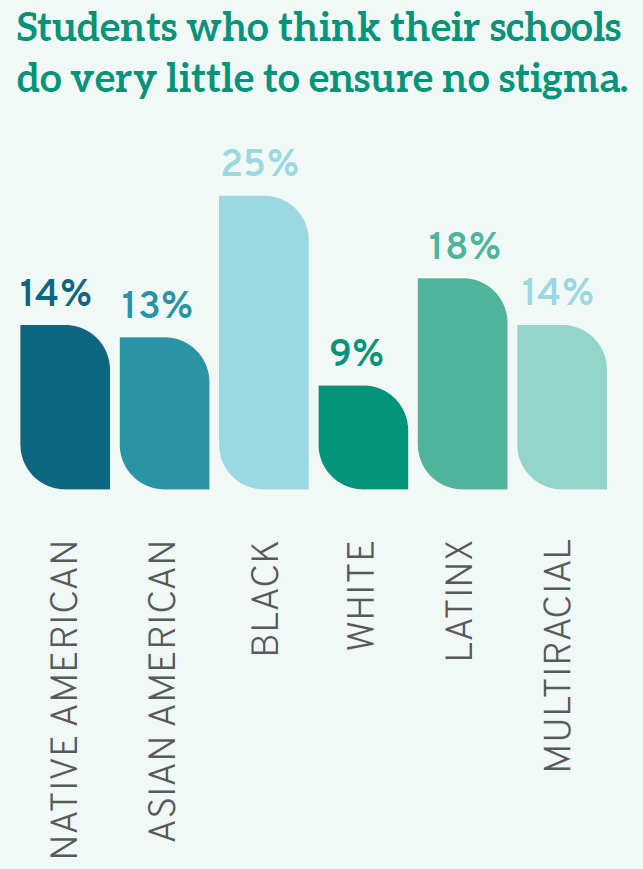
Penn State Dickinson Law has created the Antiracist Development Institute (ADI) to work in coalition with organizations and institutions to help facilitate dismantling structures that scaffold systemic racial inequality using a systems design approach. Systems design, leveraging design thinking approaches, is a vehicle to iteratively identify users and their needs to prototype and test solutions to seemingly intractable problems such as systemic racial inequality and systemic oppression. Legal education and the legal profession are starting points because of their special duty to deliver on equal justice. The ADI has identified institutional antiracism as a significant component of a multilayered strategy in the pursuit of systemic equity.
This interdisciplinary approach to legal education provides law students and lawyers the critical thinking skills that accompany introspection about the role of legal education and the legal profession in creating, interpreting, and counseling of laws that have scaffolded structural racism in American society in contravention of the fundamental value of equality vis-à-vis equal liberty, equal justice, equal citizenship, equal rights, and equal protection of the laws.
The ADI builds on the concepts and information presented throughout the “Building an Antiracist Law School, Legal Academy, and Legal Profession” book series to provide law schools and other institutions with a blueprint that will be workshopped through the stages of systems design.
“Building an Antiracist Law School, Legal Academy, and Legal Profession” is distinct in its use of a systems design approach combined with antiracist principles to transform law schools from edifices of systemic inequity into sustainable democratic institutions whose platform is built upon principles of systemic equity. It is unique for its admixture of systems design, organizational theory and practice, and antiracist theory and practice. The book series is the precursor from which the Antiracist Development Institute will use series content to develop course and workshop materials.
Over 155 colleagues from the legal academy, legal profession, and adjacent organizations are contributing to the book series as chapter contributors, editors, content reviewers, and workshop facilitators, representing 62 institutions across the country.
To get involved in this project, please complete this involvement survey.
Part 1: Part-Time Students & the Law School Experience
Around 12% of law students attend part-time. This subpopulation of law students has a unique experience that differs from that of their full-time colleagues. In part one of this two-part series, we will explore the characteristics of part-time law students and describe some of the ways that they engage with the law school community and environment. In part two, we will look at how satisfied part-time students are with their law schools and the extent to which they feel supported in their success as students and as future legal professionals.
Part-time students tend to be somewhat older than their full-time classmates. Sixty percent of part-time students are over thirty years old compared to 14% of full-time students. In fact, one quarter (25%) of part-time students are over 40 compared to just 3% of full-time students. However, the proportions of men, women, and people of another gender identity are about equal between the two groups. Part-time students are more likely to be first generation (defined as a person whose parents did not graduate college) with over a third of part-timers (36%) falling into this category compared to only a quarter (25%) of full-timers. Part-time students are also more likely to be Black or Latinx.
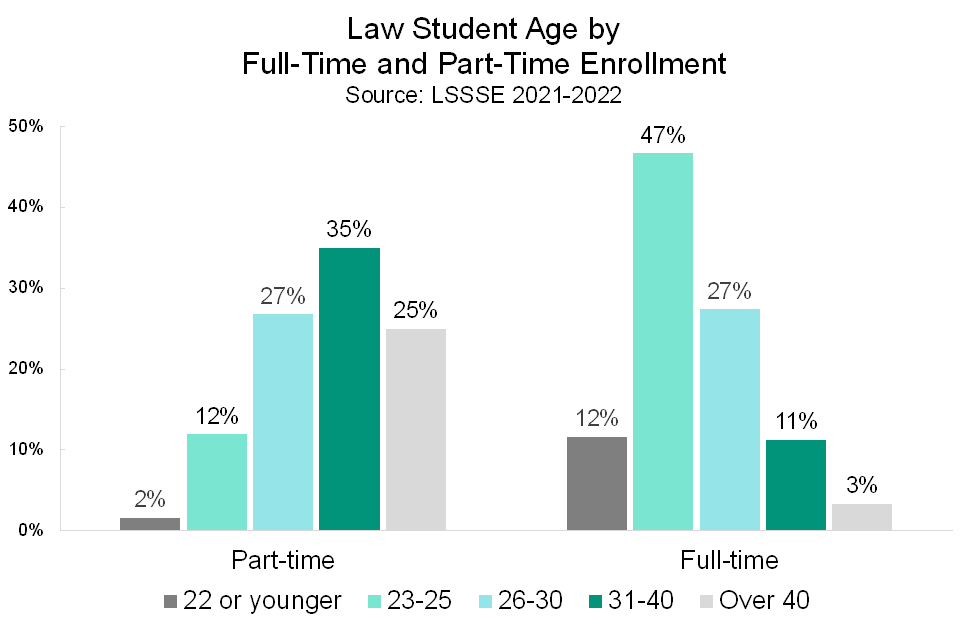
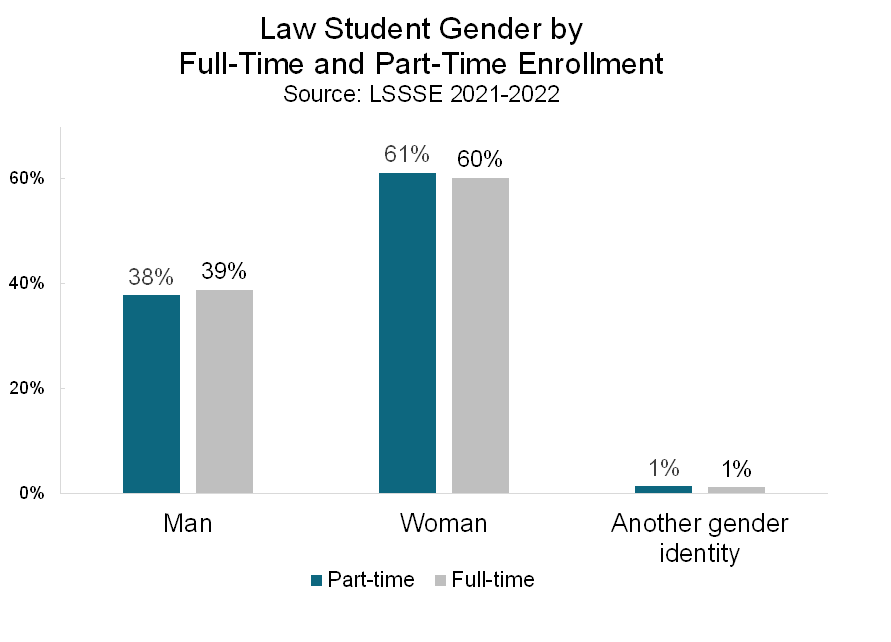
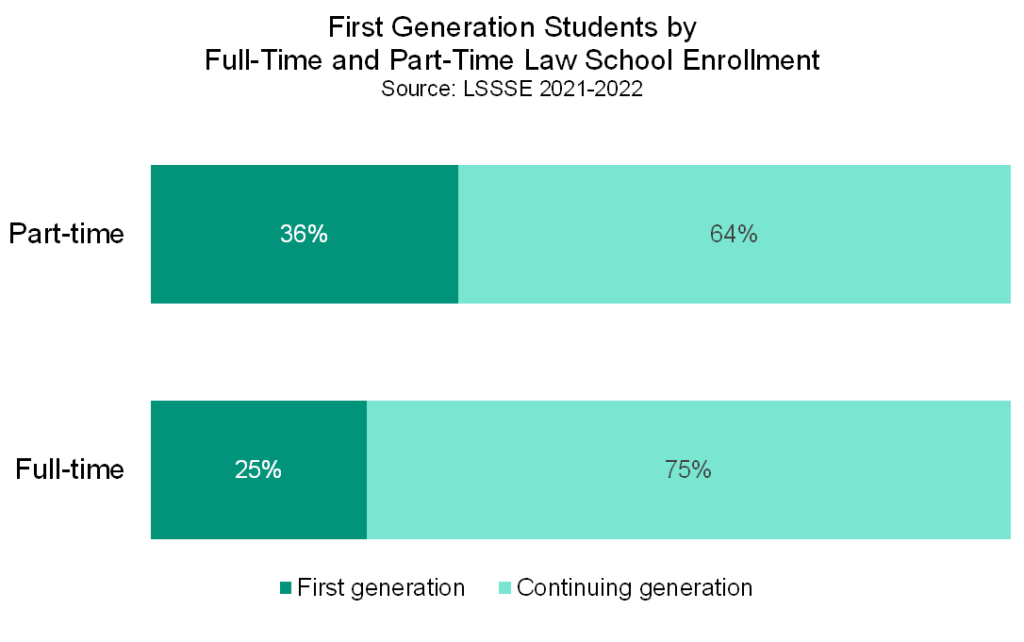
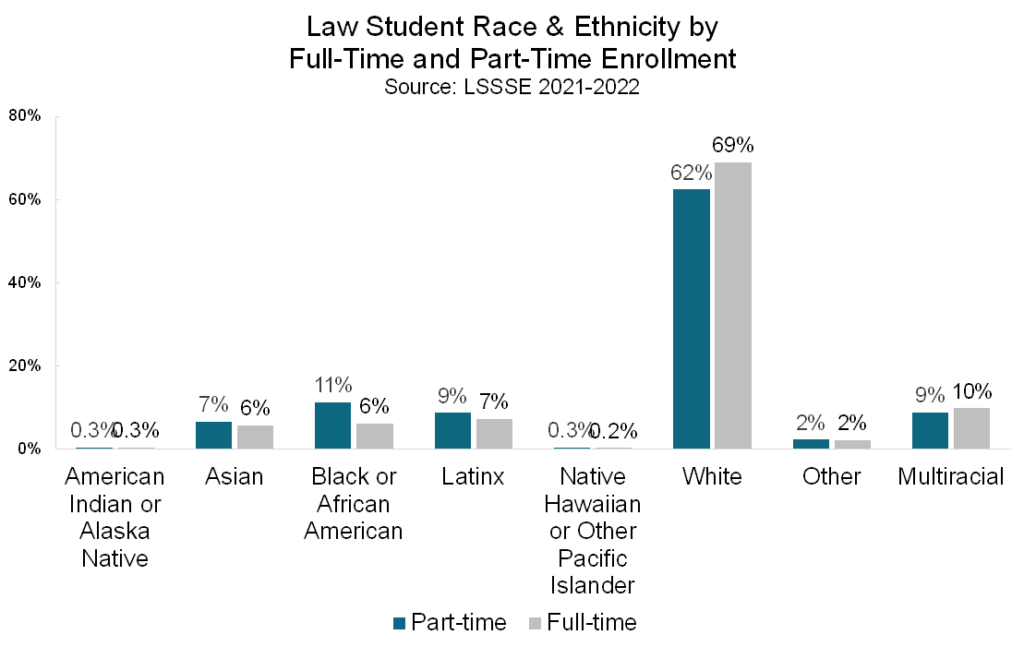
Part-time students are more likely than full-time students to expect to have no law school debt upon graduation, possibly because some part-time students are attending law school with the financial support of their employers. However, part-time students are also slightly more likely than full-time students to expect to owe more than $200,000, which is the highest debt category that LSSSE records. Seven percent of part-time students expect to owe this much compared to five percent of full-time students.
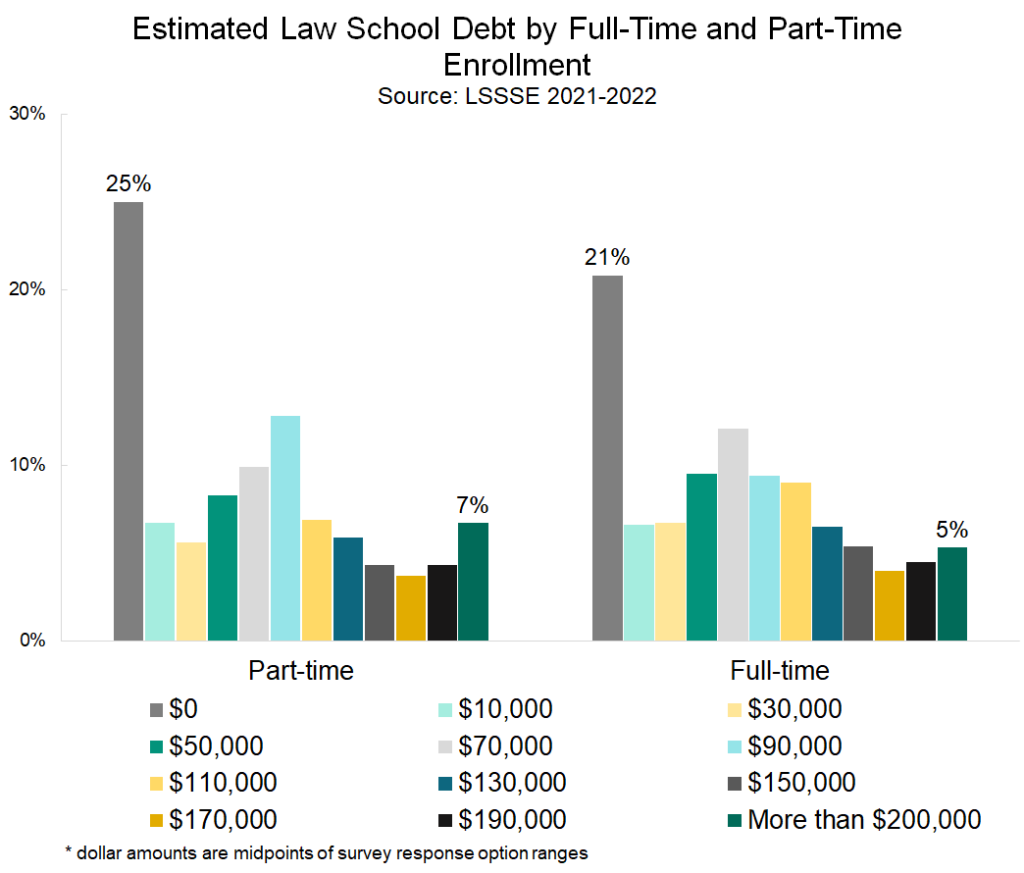
In terms of engagement with their coursework, more full-time students than part-time students frequently work with classmates outside of class to prepare class assignments. However, more part-time students frequently work with other students on projects during class time. Part-time students are somewhat less likely to engage in enriching experiences than their full-time counterparts, perhaps because they are more likely to have more intense work and family responsibilities. Still, about two-thirds (65%) of part-time students have completed or plan to participate in field placements and about two-thirds (67%) of part-time students have completed or plan to participate in public service. Additionally, over half (53%) of part-time students will join a law student organization before graduation. Part-time students are less likely than full-time students to partake in these opportunities, but their participation rates are still reasonably high given the other demands on their time.
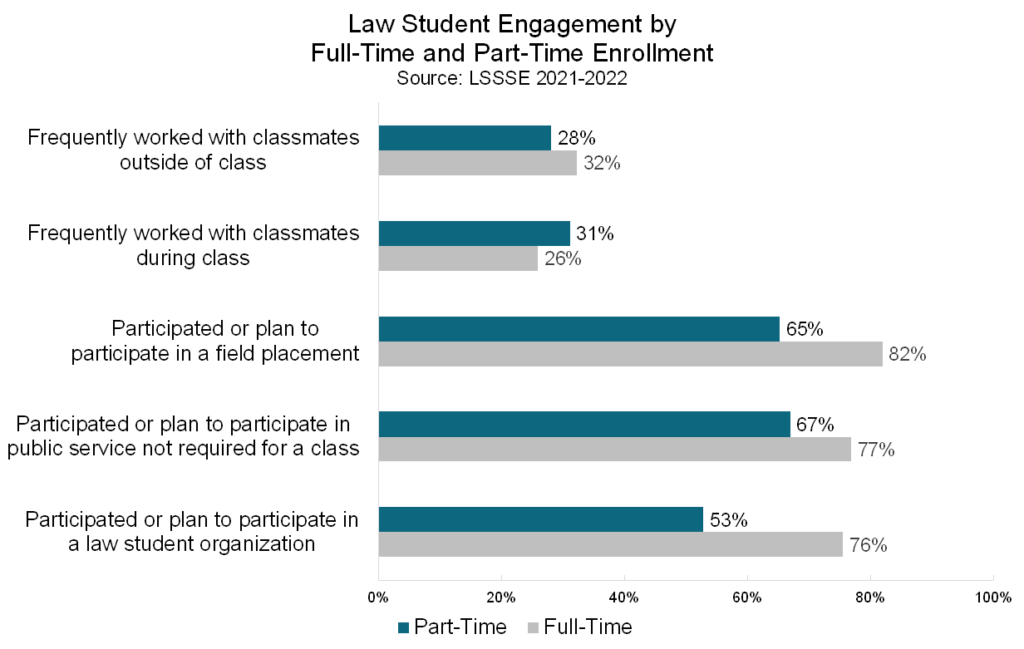
Part-time students find ways to make the law school experience their own. This group of students tends to be older and slightly more ethnically diverse, and they are somewhat less likely to add enriching law school experiences to their schedules. In our next post, we will examine part-time students’ feeling toward their law schools and the support they receive from faculty and administrators.
Guest Post: From Candidate to Law Student: Collaboration and Collective Efforts to Support LGBTQ+ Inclusion
Guest Post: From Candidate to Law Student: Collaboration and Collective Efforts to Support LGBTQ+ Inclusion

Elizabeth Bodamer, J.D., Ph.D. (she/her/ella)
Director of Research
Law School Admission Council, Inc. (LSAC)

Judi O'Kelley, J.D. (she/her/hers)
Chief Program Officer
National LGBTQ+ Bar Association (LGBTQ+ Bar)
The 2022 matriculant class in law school today is the most diverse class in the history of legal education. We have made progress, but there is more work to be done.
Diversity, equity, and inclusion efforts are needed not just at the admission stage, but throughout the prelaw-to-practice pathway. Law schools play a crucial role in creating an effective and supportive learning environment is important for everyone, particularly for LGBTQ+ students. LSSSE data shared in a blog post last year reveal that gender diverse and LGBQ law students were more likely than cisgender and straight students to report not feeling comfortable being themselves at their law schools.
Figure 1: Students Reporting Not Feeling Comfortable Being Themselves

Source: Data from the 2020 Law School Survey of Student Engagement Diversity and Inclusiveness Module. Data collected from over 5,000 law students across 25 law schools. LGBQ students represented about 14% of the sample and gender diverse students represented 1% of the sample.
It is within this context that LSAC and the LGBTQ+ Bar have worked to provide candidates, students, and law schools with data about the experience of LGBTQ+ students in addition to information about the availability of LGBTQ+ inclusive policies, practices, supports and resources.
Surveys administered by LSAC and by the LGBTQ+ Bar have found that schools are making progress in supporting LGBTQ+ applicants, students, faculty and staff. For example, the LGBTQ+ Bar found that that 99 participating schools (96.1% of survey participants) self-report that they allow transgender and nonbinary students who have not legally changed their names to have their name-in-use reflected on applications and forms. This is a positive change from a number of years ago. The next stage of inquiry is whether schools are implementing these policies and practices in a way that improves the student experience. LSAC found that of the 110 schools who responded to their question about chosen name usage:
- 67% reported that students’ chosen names automatically appear on their orientation name tags and/or materials.
- 49% reported that students’ chosen names automatically appear on faculty class rosters, 41% reported that this action requires students to submit a request, and 5% reported that students’ chosen names cannot appear on faculty class rosters.
- Only a very small proportion of schools indicated that students’ chosen names automatically appear on their transcripts (15%) and diplomas (14%).
- Almost 40% of schools reported that students’ chosen names cannot appear on transcripts that can be sent to employers.
- Almost one-third of the schools reported that students’ chosen names cannot appear on their diploma.
Woven together, the work done by the LGBTQ+ Bar and LSAC reveal that while progress has been made in creating a more inclusive experience for LGBTQ+ students, there are areas for growth.
Supporting the LGBTQ+ community in legal education takes a collective effort. Today, we know that according to LSAC data, about 0.6% of the 2022 matriculant class self-identified as transgender, gender nonbinary, or genderqueer/gender fluid, and about 14% of the 2022 matriculants identified as LGBQ+ (i.e., not straight/heterosexual). We expect these numbers to continue to grow given the latest 2022 Gallup report that about 1 in 5 Gen Z adults identify as LGBTQ+. To support this new class and all future law students, LSAC and the LGBTQ+ Bar are collaborating to administer a joint 2023 LGBTQ+ survey to law schools. The goal is to combine our efforts to build on our robust resources and insights for applicants, current law students, and schools. In order to have impact, we must work together.
Law Students Working Harder Than They Thought Possible
Faculty hold law students to high standards. In 2022, 60% of law students frequently worked harder than they thought possible to meet faculty members’ standards or expectations. This number has generally trended upward over the last twenty years, although the lowest recorded percentage of students frequently working harder than they thought possible was still a respectable slight majority (51%) in 2006. In 2022, only 8% of students never worked harder than they thought possible.

Somewhat unsurprisingly, students who are new to law school are more likely to push themselves to their limits than students who are accustomed to law school life. Two-thirds (66%) of 1L students frequently work harder than they thought possible compared to 54% of 3Ls and 49% of 4Ls. Perhaps new law students are particularly eager to prove themselves to their professors and peers or perhaps more senior students are accustomed to the way that the law school curriculum draws out their best performance and thus already know exactly how hard they can work.

Interestingly, students who generally achieve C grades in law school are more likely to frequently work harder than they thought possible compared to students who achieve mostly A’s and B’s. This may indicate that degree of effort is not always accurately reflected by scores on papers and exams for some students.

Finally, there are gender differences in the percentage of students who surprise themselves with the intensity of their efforts. Sixty-three percent of women frequently work harder than they thought possible to meet faculty standards or expectations compared to 56% of men. People with another gender identity fall in between at 60%. Ten percent of men and people with another gender identity never work harder than they thought possible compared to only 7% of women.

The data are clear that attending law school is a challenging and demanding endeavor. Most students rise to the occasion by pushing themselves to do their best work in order to meet faculty members’ standards or expectations. Hopefully these efforts are counterbalanced by supportive law schools who also foster good self-care and community care practices for budding legal professionals.











